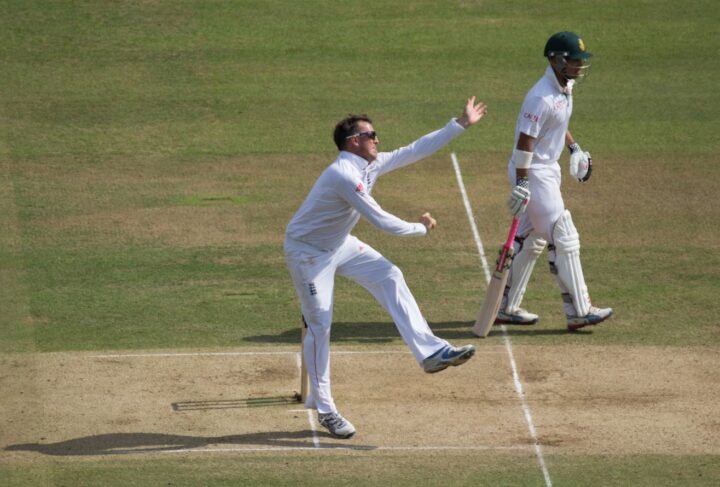Today we welcome Michael Wood back to TFT. He was some thoughts on the future of Test cricket once life gets back to normal …
After some fantastic Test cricket around the world in recent months, it seems churlish to talk money. However, as national cricket boards frantically try to recoup lost revenue by piling on more lucrative forms of the game, it is worth exploring how Test cricket might be funded in a post-COVID-19 world?
The pandemic has left cricket finances in a grim state. Cricket Australia has cut staff, player wages and recorded a deficit of £25m in their annual report. The ECB’s Chief Executive Tom Harrison has said that in the face of £200m losses, the organisation will slash its workforce budget by 20% and cut salaries for elite players. Meanwhile, counties will have their annual central payments of £3.5m reduced. Look elsewhere and you see a similar story, with jobs slashed across the game.
In a meeting of the ICC member’s Chief Executives last April, the BCCI assured other boards of their support. Jay Shah, Secretary of the BCCI, proposed rolling over the current funding structure that started in 2017, whilst collectively drafting a new revenue distribution model. It replaced ‘The Big Three’ model, which used a contribution-based revenue distribution system that gave India, England and Australia overwhelming advantages.
The move in 2017 was designed to make things fairer and the BCCI’s revenue share has reduced from £413m originally, to just over £290m for the 2015-2023 rights cycle period. For context however, the next highest grant is England’s £100m, whilst most of the remaining nations get £92m, and others less still. These ICC grants are on top of what boards make themselves. In terms of a powerhouse, the BCCI stands above the rest. As of 2018 it was worth a reported £1.4b.

This disparity means less investment in domestic first-class structures for poorer nations, leading inevitably to less competitive Test matches. As Manoj Badale, co-owner of the Rajasthan Royals writes in A New Innings, one of the key aspects of the IPL’s success model in bringing fans back time and again was initially creating a level playing field with no predictable results. If Test cricket is not as competitive, the inevitable upshot is that it is not filling grounds. And without the financial returns, no wonder the likes of Sri Lanka or Bangladesh are not playing more Test cricket.
Sri Lanka are set to play just five Tests in 2021, compared to England’s 17. Whilst sacrificing Test matches to accommodate more white ball cricket is understandable financially, how excited can anyone get from two Test series that feel contractually obliged?
The ICC recognise the problem, but their answer was to introduce the World Test Championship in 2019 to make matches more relevant and interconnected. The result has been no significant change other than bafflement over the convoluted points system. If England had won 4-0 in India, for example, they would’ve gain the same points as they did in beating Sri Lanka in two Tests.
The sad conclusion is that the ICC was trying to squeeze competitiveness from a lopsided system that they helped create. What’s more, it seems completely on brand for the ICC that the final between India and New Zealand will be played at The Ageas Bowl outside Southampton rather than somewhere in their respective countries. The final isn’t even at Lord’s.
Cricket West Indies (CWA) submitted a paper called “Economics of Cricket” to the ICC in 2018. To make international cricket more competitive, they wanted more equal distribution of ICC revenues, a bigger variety of ICC hosts and shared income in bi-lateral series. They also proposed that revenue from overseas broadcast rights and 20% from domestic broadcasts for bilateral Test and ODI series goes into a pool that is then distributed equally, in line with ICC events.
Was this paper approved? If you remember Jason Holder at the end of the series last summer publicly pleading on behalf of the CWA that England visit the Caribbean soon so that their generosity in coming to the UK could be repaid, then you won’t be surprised to learn that the answer was no.
We currently wait on whether the new ICC revenue distribution model can address these issues. Will larger boards invest more themselves in poorer nations with appropriate oversight to ensure the money ends up in the right places, developing grassroot talent and facilities?
As always, we will have to follow the money. As UK fans watched a Test series on free-to-air television for the first time since 2005, protecting and investing in the oldest form of the game around the world had never felt more important.
Michael Wood









Whatever angle you view this from the long term future of test cricket looks bleak. Neither the ICC or ECB looks to have the political will to persue it seriously as a rival to white ball. There is no coherent policy that I can see and apart from the Ashes media coverage of test cricket in this country is perfunctory at best. The traditional cricket fan, for want of a better phrase, is uniformly ignored in favour of the pursuit of a dumbed down main stream audience raised on a diet of boundaries and cheap wickets. I’m not against the white ball game per se, what I am against is the prioriting if of it at the expense of the red. There is room for all, providing the administration is separated.
“There is no coherent policy that I can see”.
Oh, they’ve been pretty coherent – in setting out to destroy Test cricket and all forms of the game except franchises in the Big Three (and I wouldn’t be too confident about Australia’s long term future).
I think Marc’s closer to it. To me, what they’ve done here is go full-on after the money whilst ignoring any balancing considerations. That’s not so much deliberately trying to destroy tests as taking a course of action in which that’s an unavoidable side-effect–which is not quite the same thing.
And, in an economy where one member contributes around 80% of the income and a single competition over half, then it’s not going to be sustainable, at least outside the Big Three (or Big One–I wouldn’t be too confident about England’s long-term prospects either).
That’s the issue that has to addressed if there really is to be “room for all”, because generally red-ball is the format that’s losing money.
It’s really disappointing all round. Out here in Australia there remains the same disdain for the West Indies who look like never touring here nor Australia there. As it stands across a fourteen month period late 20/early 22 there will be only 9 tests involving Australia. And it was disingenuous, at best, to call off the South African tour which should be happening right now. So it is, England, India and Australia will call every shot and never act outside their own self centred interest. The so called Test championship is a farce, if Australia had got there by default, I for one wouldn’t have tuned in.
Great read!
Firstly, there is no “pandemic” for Test cricket to be “after”. There’s government-imposed lockdown introduced on the back of re-branded flu peddled by vested interests dependent on the Big Pharma and Bill Gates’ teat. This is not a natural disaster.
Secondly, to see where things are heading one need no further than Colin Graves’ recent pronouncements (it’s not a “conspiracy theory” if they’re openly telling you what they’re doing and you don’t notice or grasp their meaning). Graves said the WTC is a dead duck. England’s behaviour, not fielding a full strength team when still in with a chance of making the Final, proves that is the ECB view. The WTC was only ever introduced so the ICC could say “see, we tried everything and it failed. Now bring on the big bucks.” More significant still was what Graves said about the ownership of the 16.66 teams. This is where you can see the shape of the future and it doesn’t look good.
I think I’d prefer Test cricket to die out rather than continue in a half-baked form of Second XIs playing each other to the sound of silence – or white-ball specialists looking clueless in the longer format. Arguably that’s pretty much where we’re at.
Lastly, my opinion is that people are kidding themselves if they think there’s a normalcy we’ll be returning to. The future is more likely to be endless new “variants” followed by endless new restrictions impacting on both mass gatherings and international travel. Some people don’t seem to have noticed but this “vaccine” (which isn’t a vaccine – it’s Synthetic Gene Therapy) isn’t a cure and doesn’t grant immunity, all it’s claimed to do is lessen symptoms. There may be a period of relaxation of lockdown imminent in the UK but don’t expect it to last.
Simon – as a health professional who has looked after covid patients and had the virus myself that is quite offensive to me and many others who have suffered. Please stick to cricket.
I agree David. As a Minister I have conducted the funerals of too many folk who have died of COVID-19. To suggest it is ‘re-branded flu’ is just ridiculous.
Well, it still could be a conspiracy theory–not “noticing or grasping their meaning” is arguable, subjective and says more about your attachment to that opinion than it does about what Graves was saying. In any case, Graves no longer works for the ECB.
England’s resting players (and is there really any evidence that Bairstow, Buttler and Ali–who were the only players who played in the series whose presence was at all adversely affected by the rotation policy–would have made much, or any, difference to the result?) doesn’t at all NECESSARILY say anything about their commitment to the WTC.
And I don’t at all agree with that opinion about why the WTC was introduced–which also sounds like a conspiracy theory. I would say it’s more likely to be because they were too scared or too unrealistic to address the real underlying issues, notably the disparities in income generation both between red-ball and white-ball and between India and everybody else.
Simon,. stick to the cricket and not vaccines which you seem to know little about. The vaccines give you around an 80% chance of not catching Covid 19, a virulent strain of the common cold virus and nothing to do with the flu. I’m not a health professional but I’m sure David Smith above will gladly tell you that no one knows yet whether or not the vaccine gives you long term immunity (certainly scientifically proven short term) or indeed stops you spreading it. With a third of the population now jabbed, there is an ever decreasing amount of people likely to catch it. And to be slightly contraversal while we’re at it, I’ll go one step further: lockdowns seem to have little effect on infections in the long term, they just press the pause button until you lift them. I’d agree with you that probably they have made little difference and seems rather pointless repeating something that has limited effect with all the other harm they have created. But it’s the vaccines causing this drop in cases, and one other thing rarely mentioned, the weather. It’s now getting warmer, this virus doesn’t thrive anywhere near as much as it does at under 4 degrees C. Oh and this isn’t just my opinion; I have a number of friends in health home and abroad that I have discussed this with at some length in this last year.
Anyway enough and back to the cricket.
James, apologies for going a bit off track here, but it needed answering.
I’m reading the responses to this excellent article while watching a great fightback by Zimbabwe against Afghanistan. Two minnows who are battling to establish themselves at this level. It’s gripping stuff. If only the ICC and the big 3 cared!
I don’t have Sky but Sports Mix is free on our package and has shown some of this test. I agree wholeheartedly. It may not hit the heights of the Ashes, but it certainly has some proper test drama and is well worth watching.